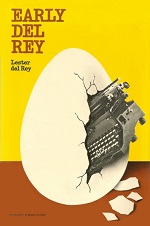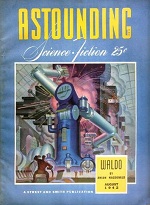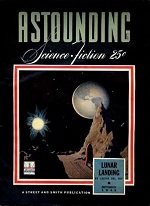|  
 
 
 
 
 | | | |  The story also appeared in this 1975 collection. The story also appeared in this 1975 collection. | | “My Name Is Legion”
by Lester del Rey
First publication: Astounding, Jun 1942

 At the end of World War II, as the Allies occupation army closes in on Hitler, a man offers him a way to bring back thousands of copies of himself from the future. At the end of World War II, as the Allies occupation army closes in on Hitler, a man offers him a way to bring back thousands of copies of himself from the future. Years ago in one of those American magazines, there was a story of a man who saw himself. He came through a woods somewhere and stumbled on a machine, got in, and it took him three days back in time. Then, he lived forward again, saw himself get in the machine and go back. Years ago in one of those American magazines, there was a story of a man who saw himself. He came through a woods somewhere and stumbled on a machine, got in, and it took him three days back in time. Then, he lived forward again, saw himself get in the machine and go back. 
Lester del Rey, Master Traveller For me, the scope of “My Name Is Legion” might well have garnered del Rey a Master Traveller Citation, but the actual award came when his 1966 juvenile novel, Tunnel Through Time, brought adventure time travel to young readers.

| |
| | | | |

 
 
 
 
 
 | | | |  | | “Time Marches On”
by Ted Carnell
First publication: Astounding, Aug 1942

 Also appearing in the first ever Probability Zero column (along with de Camp’s story, listed above, and a story by Malcolm Jameson) is Carnell’s tale of a group of science fiction authors who explore the consequences of a simple time machine that can be built from radio parts, but can take the traveler only into the future. Also appearing in the first ever Probability Zero column (along with de Camp’s story, listed above, and a story by Malcolm Jameson) is Carnell’s tale of a group of science fiction authors who explore the consequences of a simple time machine that can be built from radio parts, but can take the traveler only into the future. Yes, they were practically all here, thought Doc Smith, as his gaze moved from one to another of the circle. Williamson, Miller, Hubbard, Bond, McClary, Rocklynne, Heinlein and MacDonald, and many others who had once written about the mysteries of time travel—so many hundreds of years ago now. Yes, they were practically all here, thought Doc Smith, as his gaze moved from one to another of the circle. Williamson, Miller, Hubbard, Bond, McClary, Rocklynne, Heinlein and MacDonald, and many others who had once written about the mysteries of time travel—so many hundreds of years ago now. 
| |
| | | | |

 
 
 | | | |  | | The Anachron Stories
by Malcolm Jameson
First story: Astounding, Oct 1942

Golden-age favorite Malcolm Jameson wrote three stories of Anachron, Inc., a company that recruits ex-commandos for their “foreign” department—a euphemism for intertemporal commerce.- Anachron, Inc. (Oct 1942) Astounding
- Barrius, Imp. (Jan 1943) Astounding
- When Is When? (Aug 1943) Astounding
 We can use a limited number of agents for our “foreign” department, but they must be wiry, active, of unusually sound constitution, and familiar with the use of all types of weapons. They MUST be resourceful, of quick decision, tact and of proven courage, as they may be called upon to work in difficult and dangerous situations without guidance or supervision. Previous experience in purchasing or sales work desirable but not necessary. EX-COMMANDO MEN usually do well with us. We can use a limited number of agents for our “foreign” department, but they must be wiry, active, of unusually sound constitution, and familiar with the use of all types of weapons. They MUST be resourceful, of quick decision, tact and of proven courage, as they may be called upon to work in difficult and dangerous situations without guidance or supervision. Previous experience in purchasing or sales work desirable but not necessary. EX-COMMANDO MEN usually do well with us. 
| |
| | | | |

No Time Travel. Move along. |
“The Push of a Finger” by Alfred Bester, Astounding, May 1942 [predictions ]

| |     |